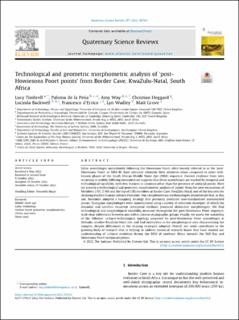| dc.contributor.author | Timbrell, Lucy | |
| dc.contributor.author | Peña, Paloma de la | |
| dc.contributor.author | Way, Amy | |
| dc.contributor.author | Hoggard, Christian | |
| dc.contributor.author | Backwell, Lucinda | |
| dc.contributor.author | d'Errico, Francesco | |
| dc.contributor.author | Wadley, Lyn | |
| dc.contributor.author | Grove, Matt | |
| dc.date.accessioned | 2023-03-08T10:17:08Z | |
| dc.date.available | 2023-03-08T10:17:08Z | |
| dc.date.created | 2022-11-13T12:09:05Z | |
| dc.date.issued | 2022 | |
| dc.identifier.issn | 0277-3791 | |
| dc.identifier.uri | https://hdl.handle.net/11250/3056976 | |
| dc.description.abstract | Lithic assemblages immediately following the Howiesons Poort, often loosely referred to as the ‘post-Howiesons Poort’ or MSA III, have attracted relatively little attention when compared to other well-known phases of the South African Middle Stone Age (MSA) sequence. Current evidence from sites occurring in widely-differing environments suggests that these assemblages are marked by temporal and technological variability, with few features in common other than the presence of unifacial points. Here we present a technological and geometric morphometric analysis of ‘points’ from the new excavations of Members 2 BS, 2 WA and the top of 3 BS members at Border Cave, KwaZulu-Natal, one of the key sites for studying modern human cultural evolution. Our complementary methodologies demonstrate that, at this site, hominins adopted a knapping strategy that primarily produced non-standardised unretouched points. Triangular morphologies were manufactured using a variety of reduction strategies, of which the discoidal and Levallois recurrent centripetal methods produced distinctive morphologies. We find technological and morphological variability increases throughout the post-Howiesons Poort sequence, with clear differences between and within chrono-stratigraphic groups. Finally, we assess the suitability of the ‘Sibudan’ cultural-technological typology proposed for post-Howiesons Poort assemblages at Sibhudu, another KwaZulu-Natal site, and find similarities in the morphological axes characterising the samples, despite differences in the shaping strategies adopted. Overall, our work contributes to the growing body of research that is helping to address historical research biases that have slanted our understanding of cultural evolution during the MSA of southern Africa towards the Still Bay and Howiesons Poort technocomplexes. | en_US |
| dc.language.iso | eng | en_US |
| dc.rights | Navngivelse 4.0 Internasjonal | * |
| dc.rights.uri | http://creativecommons.org/licenses/by/4.0/deed.no | * |
| dc.title | Technological and geometric morphometric analysis of ‘post-Howiesons Poort points’ from Border Cave, KwaZulu-Natal, South Africa | en_US |
| dc.type | Journal article | en_US |
| dc.type | Peer reviewed | en_US |
| dc.description.version | publishedVersion | en_US |
| dc.rights.holder | Copyright 2022 the authors | en_US |
| dc.source.articlenumber | 107813 | en_US |
| cristin.ispublished | true | |
| cristin.fulltext | original | |
| cristin.qualitycode | 2 | |
| dc.identifier.doi | 10.1016/j.quascirev.2022.107813 | |
| dc.identifier.cristin | 2072915 | |
| dc.source.journal | Quaternary Science Reviews | en_US |
| dc.relation.project | Norges forskningsråd: 262618 | en_US |
| dc.identifier.citation | Quaternary Science Reviews. 2022, 297, 107813. | en_US |
| dc.source.volume | 297 | en_US |

